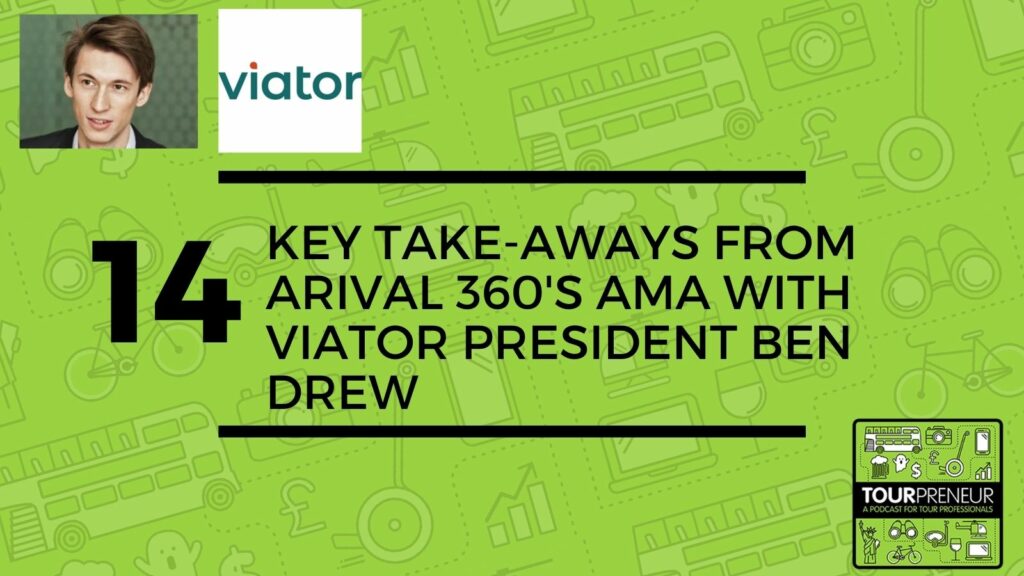Tourpreneur’s Shane Whaley reflects on the Ben Drew session on the first day of Arival 360.

Reflecting back on day 1 of Arival 360 and the Ask Me Anything session with Viator President Ben Drew, these are 14 key takeaways that really stood out for me and are likely to make a big impact on the tours and activities industry going forward. (Well, maybe not the 14th.)
Ben Drew’s session drew some interesting reactions from Tour Operators on our Facebook Group which I urge you to read.
1. For Viator customers, there is a much bigger emphasis on last-minute travel or late bookings.
The proportion of bookings booked at the last minute has gone up by 38%, that is the proportion, not the actual amount. Ben Drew clarified that they consider last-minute booking to be 0-7 days out. He added that bookings within 0-24hrs have ‘significantly increased.’
2. The proportion of bookings made within 500 miles of the home has actually doubled.
And the proportion of bookings made more than 500 miles away from your home location has declined correspondingly.
3. Viator is now starting to look at where a traveler lives so they can better serve local search.
Ben Drew was quick to point out though that Viator does not believe that the long-term travel trends for international destinations will go away.
‘I think we’ll see a boom in US domestic travel, next year, which you know, is a great opportunity. I think for a lot of tour operators on both sides of the Atlantic.’
4. ‘We have not seen a huge exit from the tour industry at this point.‘
Viator was concerned at Arival data published early on during the COVID 19 crisis suggesting that many tour operators could become insolvent over a prolonged period of lockdown. In order to maintain accurate listings, Viator, since early June has been contacting each tour operator whenever a booking comes in to check if the tour operator is still in business and/or operating.
5. As part of a major Viator strategy shift, the OTA wants to offer ‘the biggest choice of tours and activities but also the best quality.’
Viator has removed listings that they say were not reaching ‘acceptable standards.’ But only after they have contacted the operator to try and improve the listing.
6. The top cohort in quality get three times as many bookings as the bottom cohort of products.
7. Viator is testing a quality badge on some tours in order to draw attention to the higher quality listings.
“This is the first of many ways we in which we are going to draw attention to high-quality listings, but this is in test phase at the moment.”
8. Johannes Reck believes that ‘Likely to sell out‘ (or words to that effect) are not manually inserted but are based on Viator’s algorithm.
When challenged on this by a tour operator Ben Drew explained:
‘We’re looking at the amount of demand versus the amount of supply that we have access to not that exists in the whole market. And based on the balance of those two factors, our demand and our supply, we’re able to say whether something has a higher or lower probability, of selling out. So you can see immediately, there could be a number of reasons why, you know, we genuinely give that badge to a listing and it doesn’t necessarily reflect your kind of perspective on the destination.’
9. Viator has received fewer product listing requests since introducing a $29 listing fee but those tours that are registering are of a higher quality.
10. Although JohannViator has transitioned away from a phone based supplier support service to a chat based messenger platform.
Drew explained that supplier satisfaction levels were higher for the messenger service than telephone support. He added that despite recent layoffs, the OTA still offers good support.
11. Viator’s new commission structure is designed to ensure fairness for its suppliers.
Ben Drew mentioned that an inconsistent structure over the previous 20 years meant it became problematic to explain why one operator got a certain rate and not others.
“What we did with pricing was to define a minimum rate of participation for every market and to a category. It’s different depending on where you are in the country or the world and it’s different depending on what your tour type is a helicopter or walking tour for example.“
12. Operators could soon be able to gain more visibility (higher placements) for higher margins and ‘be able to experiment with whether paying higher margins gets them enough, extra demand to make it worthwhile.
The Viator President warned that tour operators will not be able to game the system and only those suppliers who hit the required quality levels will be able to increase its rankings by increasing commission/margins.
13. When it comes to Google, Viator is better in than out…. for now…
When asked about Google becoming a competitor in the tours and activities space, Drew explained that “Our perspective on the competitive dynamic is we are in a position where we think we get more out of it by participating than pulling out at this stage. We are in a position where we think it’s better to be around the table than not. We’ll continue to participate in these experiments and these trials that Google is running. and, we’ll see where it goes from there.“
14. And the most shocking thing I learned from my fellow Brit, Ben Drew, is that he prefers coffee over tea….
What were your takeaways from the session? Join the discussion with over 2000 peers in our Facebook Group.
“I think this is a good opportunity to hone our approach in more local markets, which we’re doing, at the moment, and have more to do on for sure.“
Ben drew, CEO, Viator

